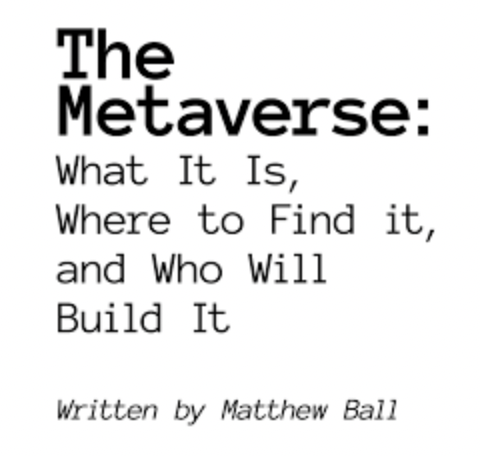Troy Warren for CNT #NFT #Crypto
The Consolidated Version of Matthew Ball’s ‘Metaverse Primer’– and what you can learn from it.
2022 has begun with a bang, as far as the metaverse goes. So far:
- Walmart is getting ready for the metaverse (as is Chipotle)
- Meta is working on a robotic eyeball to trace your eye movements
- Investors continue pouring money into virtual real estate, and
- Animoca Brands’ valuation has risen to over $5 Billion
But before the current of all things crypto and NFTs carries us away, we thought we’d take a bird’s eye view and recap influential literature on the metaverse by writer Matthew Ball.
Who is Matthew Ball?
Matthew Ball is many things – a ‘strategist’, ‘angel’, ‘advisor’, and as the NY Times puts it, a ‘prolific essayist’. He’s a seasoned venture capitalist, advisor to KKR, and co-founder of the Roundhill Ball Metaverse ETF. An avid metaverse researcher and investor, Matthew is one of the most respected writers on the subject.
Why Does His Writing Matter?

Matthew’s essay, ‘The Metaverse: What It Is, Where to Find it, and Who Will Build It’ (which sold as an NFT for 100 ETH) was one of the first texts to spell out the fundamentals on which the metaverse will be built, within the context of the nature of tech evolution. He subsequently updated it to a 9-part series called ‘The Metaverse Primer’.
Many terms we now commonly allude to the metaverse, such as ‘massively scaled’, ‘interoperable’, ‘3D virtual worlds’, ‘synchronous experience’, and ‘sense of presence’ came from Matthew’s definition of the metaverse.
He has influenced everyone from Tim Sweeney, CEO of Epic Games, to Brian Armstrong, CEO of Coinbase. Even Mark Zuckerberg ‘highly recommends’ his essays for a better understanding of the metaverse.
10 Key Insights From the ‘Metaverse Primer’
Here are key findings we’ve summarized for you from his essays:
#1. Tech-driven evolution is organic – it requires multiple innovations which build on each other until there’s mass adoption. It is also unpredictable, and we can’t know in advance how it will change the world.
#2. Tech adoption parallels user capability. Today, we’re no longer stigmatized by time spent in virtual worlds, and we are more comfortable owning purely digital assets. But it typically takes decades for consumers to change their mindsets and get familiar with advanced tech.
#3. The metaverse is not a replacement of the mobile internet, but rather ‘a quasi-successor state’ to it. The metaverse is not synonymous with virtual reality; VR is one way to experience the metaverse.
#4. As the metaverse economy grows, the demand to hire in-metaverse labor (or to outsource it) will transform work, who we hire, and where we live.
#5. The development of the fully-realized metaverse can be tracked through eight ‘core categories’ which ‘stack’ together to create the metaverse:
- hardware (VR devices, haptic gloves, and the like),
- networks, computing, interoperability, payments,
- virtual platforms, metaverse content, assets, and services
user behavior
#6. It’s likely that sensors tracking facial features will ‘live map’ a player’s face onto her metaverse avatar. It’s likely that cameras will make it possible to produce ‘digital twins’ mirroring the physical world, and that these reproductions will be in real-time.
#7. For the metaverse to become a reality, networking aspects will need to evolve to the level of AAA multiplayer games. Bandwidth needs to rise, and data travel time needs to reduce. Lastly, hardware devices need to be able to ‘receive’ a ‘superabundance’ of cloud-streamed data.
#8. The metaverse can’t thrive unless developers do; the blockchain provides an open-standard and fair system towards increasing revenue potential of ‘resalable, truly ownable, and interoperable goods’ in a manner that is impossible for a competitor to fudge.
#9. Brands with popular IP will be important in the metaverse. Existing brands that capture our imaginations or help us in signaling and expressing ourselves will likely thrive, as will new ones that create the kind of content the metaverse needs.
#10. The ‘iPad Native’ generation already uses virtual worlds to express themselves, learn, play, and socialize. These worlds will become more capable, important, and easier to use; parallelly, users will mature, consuming, creating, and leading more in the metaverse.


































